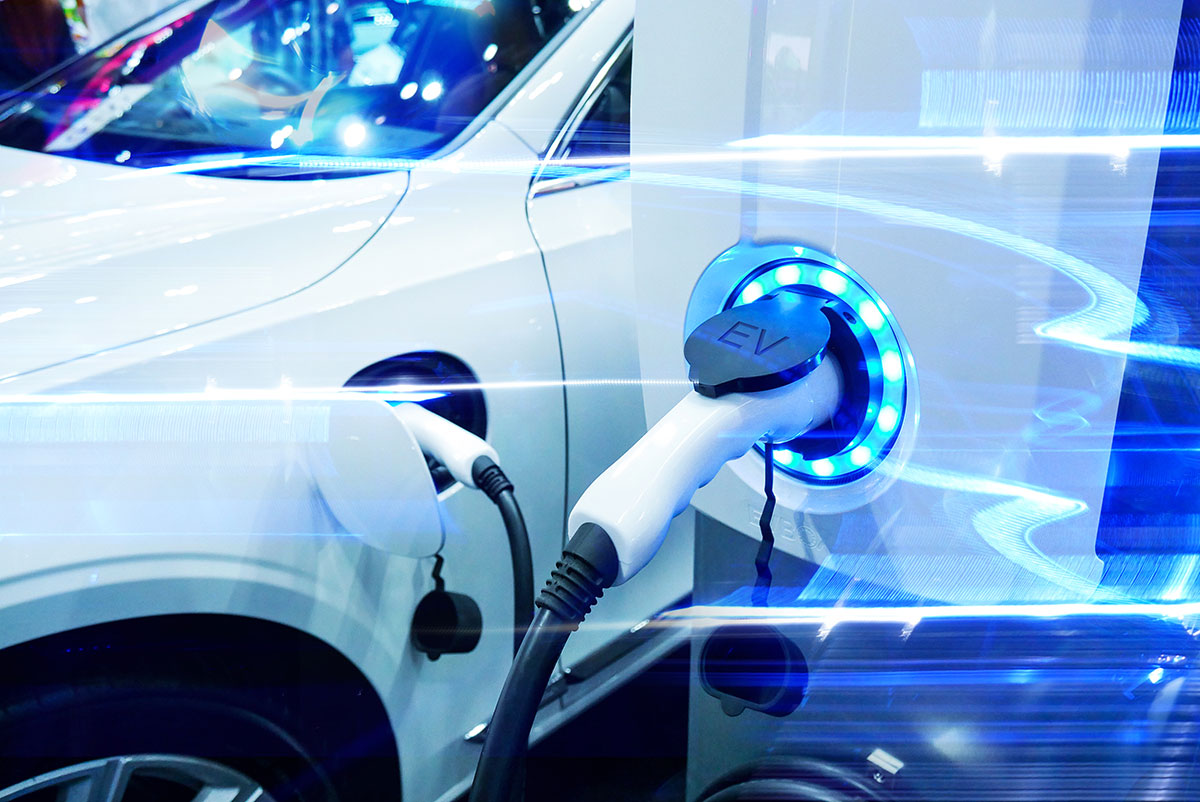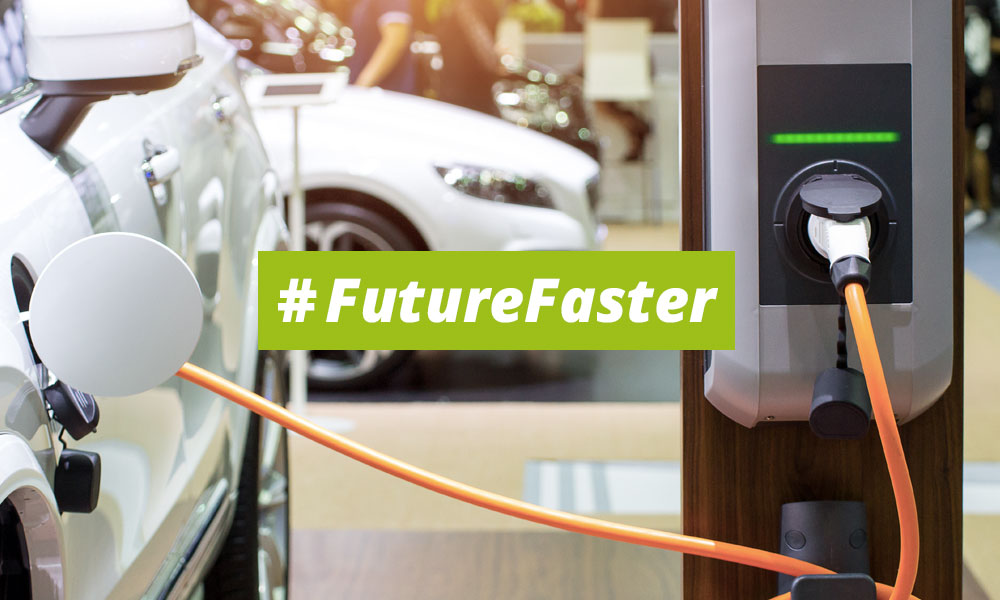Geneva Motor Show: The electric vehicle future has arrived
Nigel Topping, CEO of the We Mean Business coalition
To find out more about We Mean Business and our work on electric vehicles, please fill in the form at the bottom of this article and a member of our team will be in touch.
The Geneva Motor Show sets the tone for the international auto industry and this year there is one clear message – the electric vehicle (EV) future has arrived.
There are dozens of new EVs on show, from the likes of Honda, VW, Kia, Seat, Subaru and Citroen. These new vehicles cover everything from small city cars through to family sized SUVs and even supercars, such as the world’s fastest road car – the all-electric Pininfarina Battista.
Audi are so confident in the direction of travel for the industry that the German luxury automaker is only showing EVs at the event. They are unveiling four new fully electric models, four plug-in hybrids and aren’t bringing a single car that relies solely on the internal combustion engine.
Honda took the opportunity to announce plans to electrify all its vehicles in Europe by 2025, ahead of its existing goal to electrify its entire fleet by 2030.
Just a few short years ago, this radical shift in focus from the automakers would have been unimaginable. Looking back at the launches at the 2015 show, many of the electric models were still very much in the concept stage, or just futuristic blueprints. Now they are showing up as real, drivable cars, ready to accelerate the shift to 100% zero-carbon transport.
However, this latest show of strength for EVs is part of a longer-term shift that has been transforming the industry for many years. To date, virtually all of the world’s major automakers have committed to electrify part or all of their fleet, with hundreds of new electric models planned for production overall.
For example, last year Volvo committed to phase out pure gasoline cars after 2019 and will not launch another diesel model as it moves to electrify its entire fleet. And Volkswagen will launch 70 fully electric models by 2028, up from an earlier pledge to sell 50 by 2025.
This shift is being backed up by serious investment. For example, ahead of the Geneva Motor Show, the German Automotive Industry announced plans to invest nearly €60 billion ($68 billion) on electric vehicles and driverless technologies over the next three years.

This is in addition to the more than $150 billion in global investments auto manufacturers announced to achieve collective production targets of more than 13 million electric vehicles annually by around 2025, according to the ICCT.
There are several key factors driving the change, including new policies encouraging the EV rollout, growing consumer and business demand, rapid technological developments and the urgent need to tackle climate change and pollution.
Policy direction goes electric
The policy landscape is increasingly shifting towards the rapid rollout of EVs as a vital tool for reducing urban pollution and achieving the goals of the Paris Agreement.
The transport sector currently accounts for 23% of global energy-related CO2 emissions and is the fastest-growing contributor to climate change, according to the IEA. The health impacts of internal combustion engine vehicles is widespread. For example, nine out of 10 people breathe air containing high levels of pollutants, including that from transport, data from the World Health Organization (WHO) shows.
Several countries have already embraced EVs as a core solution to these problems, as well as a key driver of growth. The UK, France and Norway have all committed to phasing out gas and diesel powered light passenger vehicles completely in the coming decades. While India has a stated aim to have every vehicle sold in the country powered by electricity by 2030 and China has increasing sales quotas for EVs – starting at 10% for 2019.
In the EU, new limits on carbon dioxide emissions will take effect from 2021, and increase in 2025 and 2030.
Meanwhile 26 cities, states, and businesses that unveiled plans last year to deploy zero emission vehicle fleets, with the #ZEVChallenge, led by The Climate Group, C40 Cities and the Under2 Coalition.
These bold policy signals are vital to encourage producers and consumers to invest, but more granular policies are also critical to accelerate the transition to zero-emission fleets. For example, Norway has some of the most ambitious policy measures in place – including free city parking and reduced road tax – resulting in the highest penetration of EVs per capita at roughly one third of the population.
Demand is going exponential
EV sales made up a miniscule 1% of the global auto market less than two years ago, but today consumer and business demand are driving exponential growth in market share. For example, Chinese plug-in electric vehicle (PEV) sales jumped 175% in February 2019 year-on-year to grab a share of 4.8% in the world’s biggest auto market.
The critical corporate market for vehicles is giving a clear demand signal for the transition to EVs. To date over 30 multinational companies have committed to accelerating the rollout of EVs and charging infrastructure with the EV100 initiative, including Chinese search giant Baidu, the world’s leading mail and logistics company Deutsche Post DHL Group, fleet operator LeasePlan and the world’s largest furniture retailer Ingka Group (IKEA).
These companies were joined this month by national postal companies Swiss Post and Austrian Post, who also committed to the initiative led by The Climate Group. Collectively, The Climate Group has secured the electrification of more than 2 million vehicles by 2030, the latest EV100 report shows.
Technology makes it all possible
Underpinning the accelerating shift to EVs are the dynamic technological developments. These cars are now able to go further and faster than thought possible just a few years ago, helping to quash fears over range, charging, cost and reliability.
One of the key areas of development has been with batteries. New EVs, such as the Tesla Model S, can achieve a range of some 250-300 miles, which rivals many traditional cars. New entrants into the market such as Dyson are pushing for ever more efficient batteries and the growing market for batteries shows no sign of slowing down.
The global energy-storage market will surge to a cumulative 942 GW by 2040, according to Bloomberg NEF, and that growth will necessitate $1.2 trillion in investment. That storage capacity is equivalent to the entire fleet of coal-fired power stations in China.
Meanwhile the race to provide a viable charging infrastructure is getting underway, with charging infrastructure developers ChargePoint and EVBox committing to installing over 3.5 million new chargers globally by 2025.
And companies like EMotorWerks are finding innovative ways to harness the growing fleet of mobile batteries and chargers for new business opportunities. EMotorWerks are using their 10,000 connected chargers to bid into California’s wholesale power market – tapping the distributed storage capacity of cars to act as a giant battery that can deliver power to the grid.
With all these factors pushing in the same direction, it’s clear why The Geneva International Motor Show is being dominated by the shift to electric cars.
This article first appeared on Business Green
Take Action
Further reading
- How to harness the disruptive innovation of climate action
- Zero-carbon fleets are set to drive the #FutureFaster
- Read how zero-carbon grids are set to power the #FutureFaster
Speak to a member of our team
Please fill in the form below and a member of the We Mean Business team will be in touch.

